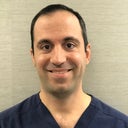Don't get bamboozled. Ptosis surgery is a highly specialized practice. You need an oculoplastic surgeon who focused on aesthetic reconstructive eyelid surgery. Plastic surgeons who focus on liposuction and breast surgery or facial plastic surgeons generally to not offer the highly expert skill needed to address upper eyelid surgery. This is not like cosmetic blepharoplasty. This is fussy surgery that has to be done right. In my opinion, you have obvious bilateral upper eyelid ptosis that is worse on the right side. On the right side you appear to have a significant central disinsertion of the right upper eyelid levator aponeurosis. The crease is very high and incompletely formed. There is eyelash ptosis on the right side, and profound compensatory eyebrow elevation. However you also have left upper eyelid ptosis and also a left eyebrow compensation. The "test" alluded to by one of the posters is called a neosynephrine test. These drops are instilled in the eyes and stimulate the Mueller's muscle. This is an accessory muscle on the back side of the eyelid that is sympathetically innervated. It simulates the effect of a very popular ptosis surgery called a Muellerectomy or Mueller's muscle conjunctival resection ptosis surgery. It is so popular because the anatomy is very simple and the surgery is very quick. The problem is that surgery is not what you need. You most likely have a disinserted central levator aponeurosis. The Muellerectomy relies on the tendon being in the right place to be effective to fold the tendon and strengthen its function. The Muellerectomy will not work to restore the eyelid position. Does that stop eyelid surgeons from trying. I have had to fix patients who have had 2, 3, 4, and 5 Muellectomies. You also need to have your eyelid crease reformed at a lower position. When the crease is reformed (anchor blepharoplasty), the eyelid ptosis is fixed, and the eyelash ptosis is addressed (with the anchor blepharoplasty), the eyebrows will relax to a more natural location helping restore an outie eyelid. Surgery is very comfortably perform under light intravenous sedation. You also need a detailed personal assessment. Your astigmatism has nothing to do with your ptosis. Your eyes can be your best feature.




